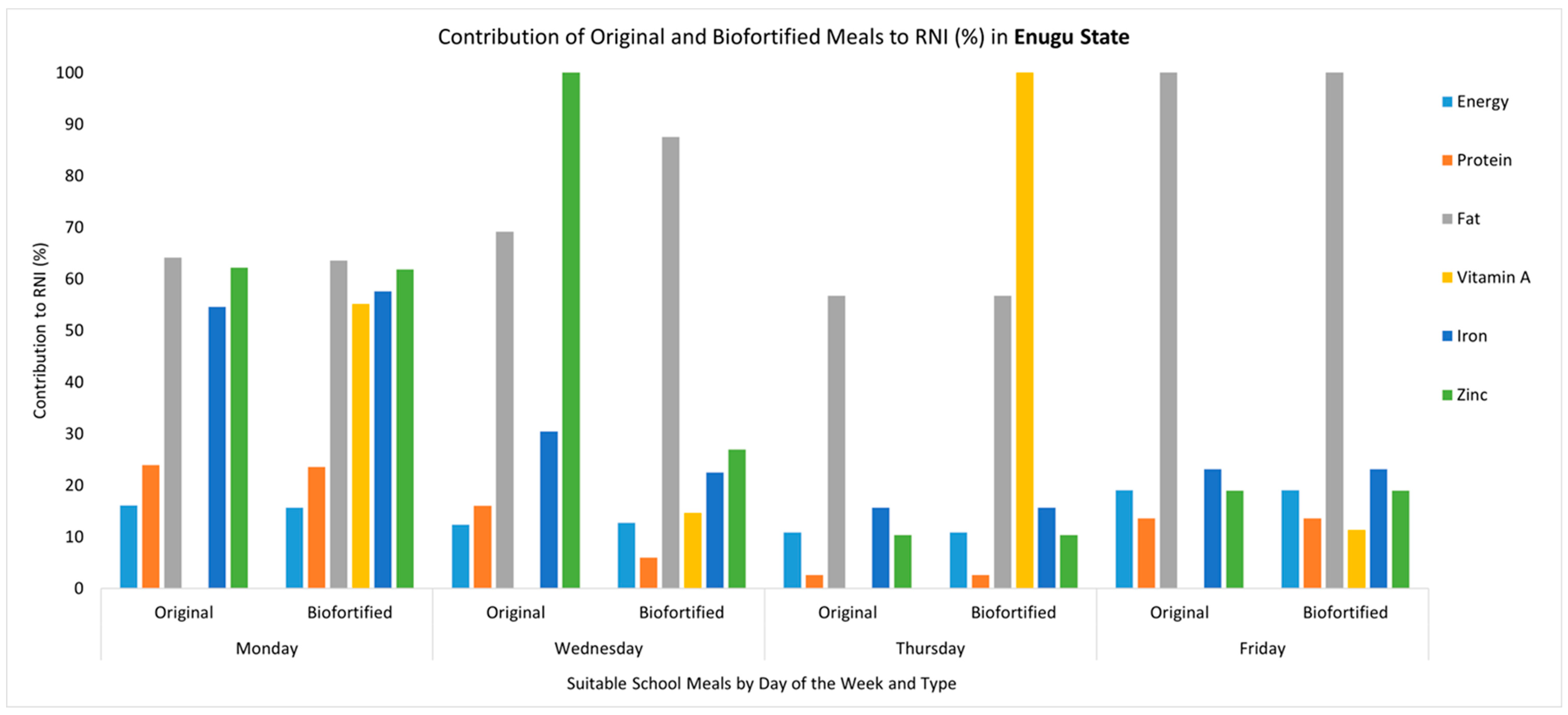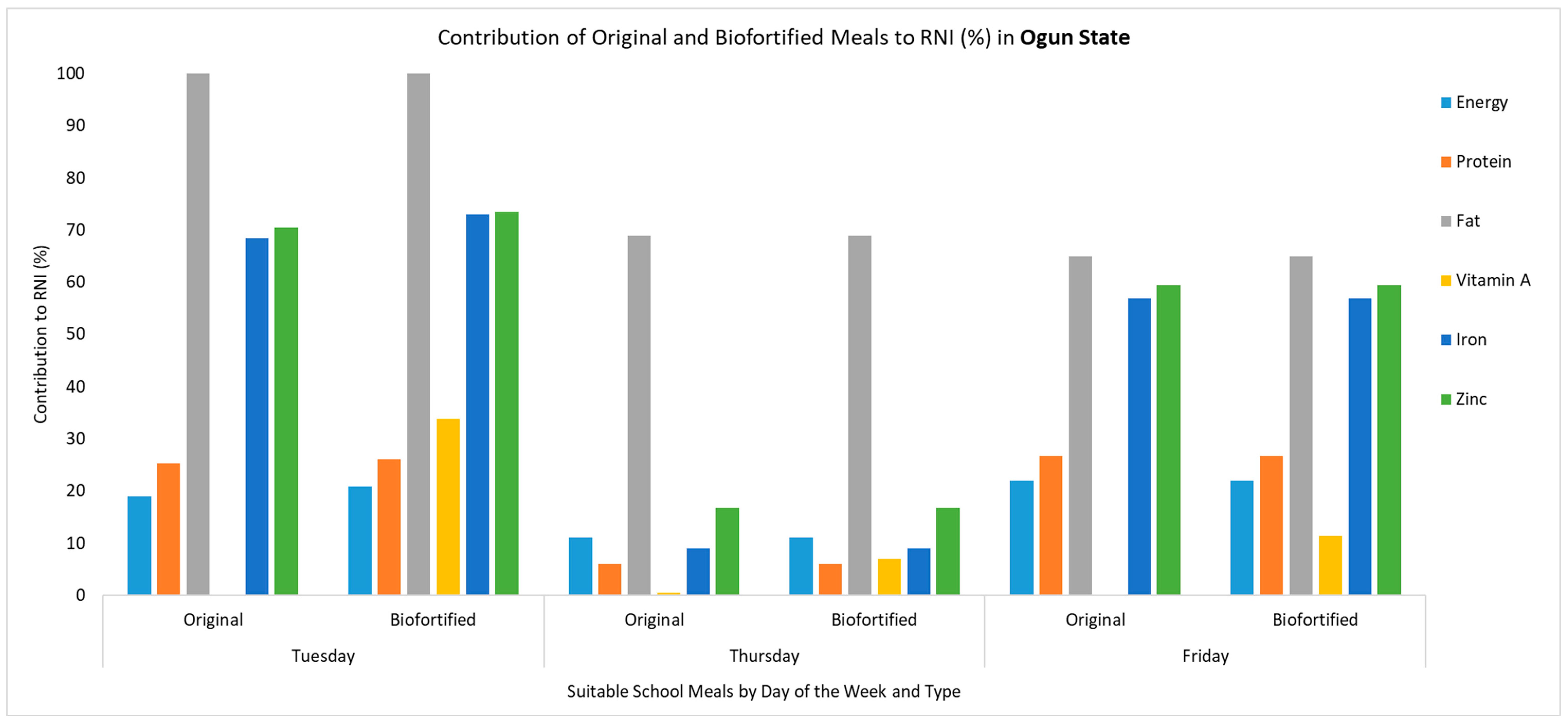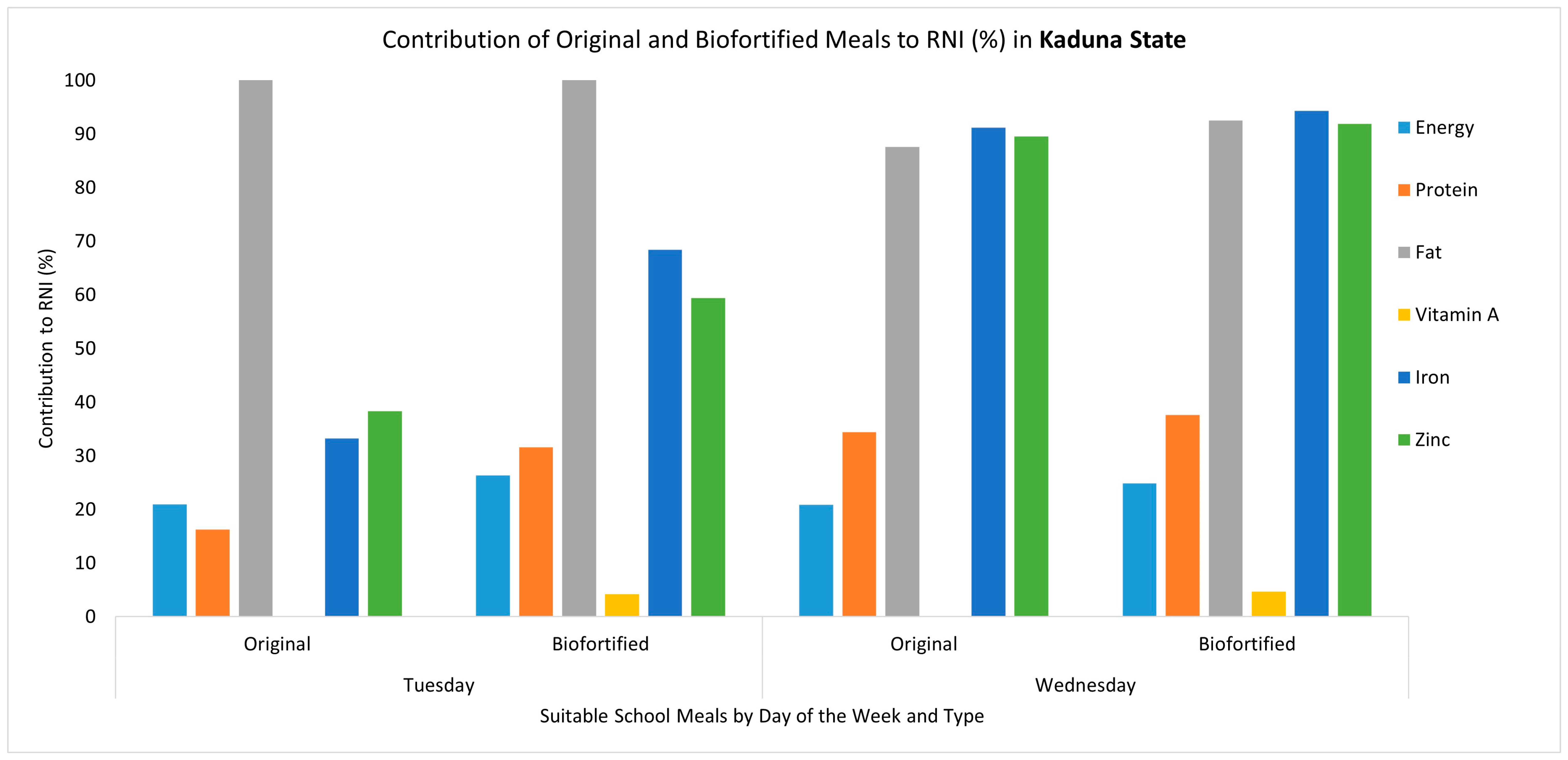Availability, Affordability, Awareness, Preferences and Nutritional Impact of Biofortified Crops in Nigeria
Abstract
1. Introduction
2. Materials and Methods
2.1. Field Market Survey Methodology
2.2. Geographical and Economic Context
2.3. Key Informant Interviews
2.4. Simulation Study Methodology
2.5. Data Analysis
3. Results
3.1. Availability and Affordability of Biofortified Crops
3.1.1. Availability
3.1.2. Affordability
3.2. Awareness, Perceptions, and Preferences
3.3. Biofortified Crops and Nutrient Levels
Cost Implications
4. Discussion
5. Conclusions and Policy Implications
Supplementary Materials
Author Contributions
Funding
Institutional Review Board Statement
Informed Consent Statement
Data Availability Statement
Acknowledgments
Conflicts of Interest
Abbreviations
| MND | Macronutrient Deficiency |
References
- Bailey, R.L.; West, K.P., Jr.; Black, R.E. The Epidemiology of Global Micronutrient Deficiencies. Ann. Nutr. Metab. 2015, 66, 22–33. [Google Scholar] [CrossRef] [PubMed]
- Black, M.M. Zinc deficiency and child development123. Am. J. Clin. Nutr. 1998, 68, 464S–469S. [Google Scholar] [CrossRef] [PubMed]
- Zimmermann, M.B. Iodine Deficiency. Endocr. Rev. 2009, 30, 376–408. [Google Scholar] [CrossRef] [PubMed]
- Roth, D.E.; Abrams, S.A.; Aloia, J.; Bergeron, G.; Bourassa, M.W.; Brown, K.H.; Calvo, M.S.; Cashman, K.D.; Combs, G.; De-Regil, L.M.; et al. Global prevalence and disease burden of vitamin D deficiency: A roadmap for action in low- and middle-income countries. Ann. N. Y. Acad. Sci. 2018, 1430, 44–79. [Google Scholar] [CrossRef]
- Stevens, G.A.; Beal, T.; Mbuya, M.N.N.; Luo, H.; Neufeld, L.M.; Addo, O.Y.; Adu-Afarwuah, S.; Alayón, S.; Bhutta, Z.; Brown, K.H.; et al. Micronutrient deficiencies among preschool-aged children and women of reproductive age worldwide: A pooled analysis of individual-level data from population-representative surveys. Lancet Glob. Health 2022, 10, e1590–e1599. [Google Scholar] [CrossRef]
- UNICEF. National Food Consumption and Micronutrient Survey 2021; UNICEF: New York, NY, USA, 2024; Available online: https://www.unicef.org/nigeria/media/9271/file/%20National%20Food%20Consumption%20and%20Micronutrient%20Survey%20(2021).pdf (accessed on 5 September 2024).
- Mekonnen, D.A.; Akerele, D.; Achterbosch, T.; de Lange, T.; Talsma, E.F. Affordability of Healthy and Sustainable Diets in Nigeria. Front. Sustain. Food Syst. 2021, 5, 726773. [Google Scholar] [CrossRef]
- FAO. The State of Food Security and Nutrition in the World. 2020. Available online: https://openknowledge.fao.org/items/ebe19244-9611-443c-a2a6-25cec697b361 (accessed on 9 March 2025).
- Bouis, H.E.; Saltzman, A. Improving nutrition through biofortification: A review of evidence from HarvestPlus, 2003 through 2016. Glob. Food Secur. 2017, 12, 49–58. [Google Scholar] [CrossRef]
- Andretti, B.; Vieites, Y.; Elmor, L.; Andrade, E.B. EXPRESS: How Socioeconomic Status Shapes Food Preferences and Perceptions. J. Mark. 2024, 1–24. [Google Scholar] [CrossRef]
- Okiror, F. African Union Endorses Biofortification to Tackle Malnutrition and Enrich School Meals. HarvestPlus. Available online: https://www.harvestplus.org/african-union-endorses-biofortification-to-tackle-malnutrition-and-enrich-school-meals/ (accessed on 25 November 2024).
- Nestel, P.; Bouis, H.E.; Meenakshi, J.; Pfeiffer, W. Biofortification of Staple Food Crops1,2. J. Nutr. 2006, 136, 1064–1067. [Google Scholar] [CrossRef]
- WHO. Guidelines on Food Fortification with Micronutrients. World Health Organization. 2006. Available online: https://apps.who.int/iris/bitstream/handle/10665/43412/9241594012_eng.pdf (accessed on 25 November 2024).
- Rosado, J.L.; Hambidge, K.M.; Miller, L.V.; Garcia, O.P.; Westcott, J.; Gonzalez, K.; Conde, J.; Hotz, C.; Pfeiffer, W.; Ortiz-Monasterio, I.; et al. The Quantity of Zinc Absorbed from Wheat in Adult Women Is Enhanced by Biofortification. J. Nutr. 2009, 139, 1920–1925. [Google Scholar] [CrossRef]
- Signorell, C.; Zimmermann, M.B.; Cakmak, I.; Wegmüller, R.; Zeder, C.; Hurrell, R.; Aciksoz, S.B.; Boy, E.; Tay, F.; Frossard, E.; et al. Zinc Absorption From Agronomically Biofortified Wheat Is Similar to Post-Harvest Fortified Wheat Is a Substantial Source of Bioavailable Zinc in Humans. J. Nutr. 2019, 149, 840–846. [Google Scholar] [CrossRef]
- Afolami, I.; Mwangi, M.N.; Samuel, F.; Boy, E.; Ilona, P.; Talsma, E.F.; Feskens, E.; Melse-Boonstra, A. Daily consumption of pro-vitamin A biofortified (yellow) cassava improves serum retinol concentrations in preschool children in Nigeria: A randomized controlled trial. Am. J. Clin. Nutr. 2021, 113, 221–231. [Google Scholar] [CrossRef] [PubMed]
- Hotz, C.; Loechl, C.; Lubowa, A.; Tumwine, J.K.; Ndeezi, G.; Masawi, A.N.; Baingana, R.; Carriquiry, A.; de Brauw, A.; Meenakshi, J.V.; et al. Introduction of β-Carotene–Rich Orange Sweet Potato in Rural Uganda Resulted in Increased Vitamin AIntakes among Children Women Improved Vitamin AStatus among Children 3. J. Nutr. 2012, 142, 1871–1880. [Google Scholar] [CrossRef]
- Rewa Misra, L.O. Call for Action to Address Hidden Hunger: Enabling Biofortification to Address Micronutrient Deficiencies. 2021. Available online: https://www.harvestplus.org/wp-content/uploads/2023/09/Micronutrient-Deficiency-in-Nigeria.pdf (accessed on 2 September 2024).
- HarvestPlus. Nigeria; HarvestPlus: Washington, DC, USA; Available online: https://www.harvestplus.org/countries/nigeria/ (accessed on 25 November 2024).
- KDBS—Kaduna State Bureau of Statistics. Available online: https://kdbs.ng/app/uploads/2018/02/KASS-STRUCTURE-SURVEY.pdf (accessed on 24 January 2025).
- Ekholuenetale, M.; Okonji, O.C.; Nzoputam, C.I.; Barrow, A. Inequalities in the prevalence of stunting, anemia and exclusive breastfeeding among African children. BMC Pediatr. 2022, 22, 333. [Google Scholar] [CrossRef] [PubMed]
- John, C.; Poh, B.K.; Jalaludin, M.Y.; Michael, G.; Adedeji, I.; Oyenusi, E.E.; Akor, B.; Charles, N.C.; Buthmanaban, V.; Muhardi, L. Exploring disparities in malnutrition among under-five children in Nigeria and potential solutions: A scoping review. Front. Nutr. 2023, 10, 1279130. [Google Scholar] [CrossRef] [PubMed]
- Emeka, C.; Chika-Emeka, N. Cost-Return Analysis of Cocoyam Marketing in Nsukka Agricultural Zone of Enugu State, Nigeria. 2014. Available online: https://www.semanticscholar.org/paper/Cost-return-analysis-of-cocoyam-marketing-in-Nsukka-Emeka-Chika-Emeka/e37a772c1f4c14b95b6c6c58460da8ed36871803 (accessed on 24 January 2025).
- Okwuonu, I.C.; Narayanan, N.N.; Egesi, C.N.; Taylor, N.J. Opportunities and challenges for biofortification of cassava to address iron and zinc deficiency in Nigeria. Glob. Food Secur. 2021, 28, 100478. [Google Scholar] [CrossRef]
- Popay, J. Guidance on the Conduct of Narrative Synthesis in Systematic Reviews. ESRC Methods Programme. 2006. Available online: https://citeseerx.ist.psu.edu/document?repid=rep1&type=pdf&doi=ed8b23836338f6fdea0cc55e161b0fc5805f9e27 (accessed on 27 November 2024).
- Foley, J.K.; Michaux, K.D.; Mudyahoto, B.; Kyazike, L.; Cherian, B.; Kalejaiye, O.; Ifeoma, O.; Ilona, P.; Reinberg, C.; Mavindidze, D.; et al. Scaling Up Delivery of Biofortified Staple Food Crops Globally: Paths to Nourishing Millions. Food Nutr. Bull. 2021, 42, 116–132. [Google Scholar] [CrossRef]
- Oparinde, A.; Banerji, A.; Birol, E.; Ilona, P. Information and consumer willingness to pay for biofortified yellow cassava: Evidence from experimental auctions in Nigeria. Agric. Econ. 2016, 47, 215–233. [Google Scholar] [CrossRef]
- Fetuga, G.; Tomlins, K.; Henshaw, F.; Idowu, M. Effect of variety and processing method on functional properties of traditional sweet potato flour (“elubo”) and sensory acceptability of cooked paste (“amala”). Food Sci. Nutr. 2014, 2, 682–691. [Google Scholar] [CrossRef]
- Talsma, E.F.; Melse-Boonstra, A.; Brouwer, I.D. Acceptance and adoption of biofortified crops in low- and middle-income countries: A systematic review. Nutr. Rev. 2017, 75, 798–829. [Google Scholar] [CrossRef]
- Olson, R.; Gavin-Smith, B.; Ferraboschi, C.; Kraemer, K. Food Fortification: The Advantages, Disadvantages and Lessons from Sight and Life Programs. Nutrients 2021, 13, 1118. [Google Scholar] [CrossRef] [PubMed]
- Bechoff, A.; Chijioke, U.; Tomlins, K.I.; Govinden, P.; Ilona, P.; Westby, A.; Boy, E. Carotenoid stability during storage of yellow gari made from biofortified cassava or with palm oil. J. Food Compos. Anal. 2015, 44, 36–44. [Google Scholar] [CrossRef]
- Taleon, V.; Sumbu, D.; Muzhingi, T.; Bidiaka, S. Carotenoids retention in biofortified yellow cassava processed with traditional African methods. J. Sci. Food Agric. 2019, 99, 1434–1441. [Google Scholar] [CrossRef]
- Samuel, L.; de Barcellos, M.D.; Watabaji, M.D.; De Steur, H. Factors affecting farmers’ acceptance and adoption of biofortified crops: A systematic review. Outlook Agric. 2024, 53, 15–29. [Google Scholar] [CrossRef]
- African Union. Scaling Up the Access to Biofortified Seeds to Address Malnutrition in Africa. Report Number: 000003456/2023. 2023. Available online: https://au.int/sites/default/files/pressreleases/43242-pr-Press_Release_-_Scaling_up_the_access_to_biofortified_seeds_to_address_malnutrition_in_Africa.pdf (accessed on 25 October 2024).
- The Commercialisation of Biofortified Crops Programme. HarvestPlus. Available online: https://www.harvestplus.org/what-we-do/projects/cbc-project/ (accessed on 9 March 2025).
- ENRICH Project: Educating Communities on the Benefits of Biofortified Crops and Nutrition-Smart Agriculture. IFPRI. Available online: https://www.ifpri.org/blog/enrich-project-educating-communities-benefits-biofortified-crops-and-nutrition-smart/ (accessed on 9 March 2025).
- ENRICH Program Promotes Biofortified Crops in Kenya’s Land of Champions. HarvestPlus. Available online: https://www.harvestplus.org/enrich-program-promotes-biofortified-crops-in-kenyas-land-of-champions/ (accessed on 9 March 2025).
- Integrating Biofortified Crops in Home Grown School Feeding Programs in Kenya, Tanzania, and Malawi. HarvestPlus. Available online: https://www.harvestplus.org/what-we-do/projects/integrating-biofortified-crops-in-home-grown-school-feeding-programs-in-kenya-tanzania-and-malawi/ (accessed on 9 March 2025).



| Crops per State | Biofortified Crops | Non-Biofortified Crops | ||||
|---|---|---|---|---|---|---|
| Total Count | Typical Availability (Count) | Average Price | Total Count | Typical Availability (Count) | Average Price | |
| Enugu | ||||||
| Cassava | 2 | Rarely available (n = 2) | 5500 | 8 | Always available (n = 8) | 2275 |
| Maize | 19 | Always available (n = 17); only in season (n = 1); rarely available (n = 1) | 2336.84 | 71 | Always available (n = 66); rarely available (n = 5) | 3289.86 |
| Millet | 3 | Always available (n = 3) | 3500 | 5 | Always available (n = 5) | 2740 |
| Sweet Potato | 19 | Always available (n = 4); only in season (n = 3); rarely available (n = 12) | 2889.47 | 101 | Always available (n = 76); only in season (n = 18); rarely available (n = 7) | 1457.91 |
| Kaduna | ||||||
| Cassava | 0 | na | na | 0 | na | na |
| Maize | 134 | Always available (n = 30); only in season (n = 9); rarely available (n = 94) | 704.98 | 0 | na | na |
| Millet | 0 | na | na | 0 | na | na |
| Sweet Potato | 0 | na | na | 0 | na | na |
| Ogun | ||||||
| Cassava | 0 | na | na | 52 | Always available (n = 52) | 5765.38 |
| Maize | 1 | Only in season (n = 1) | 400 | 143 | Always available (n = 91); only in season (n = 49); rarely available (n = 3) | 1493.71 |
| Millet | 0 | na | na | 0 | na | na |
| Sweet Potato | 0 | na | na | 130 | Always available (n = 104); only in season (n = 22); rarely available (n = 4) | 1158.46 |
| Crops per State | Consumers | Sellers | ||||
|---|---|---|---|---|---|---|
| Awareness | Visual Difference | Consumer Preference | Visual Difference | |||
| (% of consumers aware of biofortified crops) | (% of consumers able to differentiate between biofortified and non-biofortified crops) | (% of consumers preferring biofortified crops) | (% of consumers with no preference between biofortified crops and non-biofortified crops) | (% of consumers preferring non-biofortified crops) | (% of sellers able to differentiate between biofortified and non-biofortified products) | |
| Enugu | ||||||
| Cassava | 30 | 30 | 30 | 0 | 70 | 30 |
| Maize | 16.67 | 60 | 21.11 | 21.11 | 57.78 | 65.55 |
| Millet | 0 | 0 | 0 | 37.5 | 62.5 | 0 |
| Sweet Potato | 20.83 | 60 | 10 | 22.4 | 67.5 | 67.5 |
| Kaduna | ||||||
| Maize | 17.16 | 22.39 | na | na | na | 67.91 |
| Ogun | ||||||
| Cassava | 11.54 | 21.15 | 0 | 23.08 | 76.92 | 42.31 |
| Maize | 2.08 | 22.92 | 0.69 | 43.05 | 63.19 | 36.11 |
| Sweet Potato | 16.15 | 36.15 | 1.53 | 43.85 | 54.61 | 45.38 |
| Average Price | ||
|---|---|---|
| Crop Type | Biofortified | Non-Biofortified |
| Cassava | 5500 | 4020.19 |
| Maize | 1147.27 | 2391.78 |
| Millet | 3500 | 2740 |
| Sweet Potato | 2889.47 | 1308.18 |
Disclaimer/Publisher’s Note: The statements, opinions and data contained in all publications are solely those of the individual author(s) and contributor(s) and not of MDPI and/or the editor(s). MDPI and/or the editor(s) disclaim responsibility for any injury to people or property resulting from any ideas, methods, instructions or products referred to in the content. |
© 2025 by the authors. Licensee MDPI, Basel, Switzerland. This article is an open access article distributed under the terms and conditions of the Creative Commons Attribution (CC BY) license (https://creativecommons.org/licenses/by/4.0/).
Share and Cite
Atanasova, P.; Singh, S.; Adebayo, A.; Adekunle, F.; Adesanmi, A. Availability, Affordability, Awareness, Preferences and Nutritional Impact of Biofortified Crops in Nigeria. Nutrients 2025, 17, 1036. https://doi.org/10.3390/nu17061036
Atanasova P, Singh S, Adebayo A, Adekunle F, Adesanmi A. Availability, Affordability, Awareness, Preferences and Nutritional Impact of Biofortified Crops in Nigeria. Nutrients. 2025; 17(6):1036. https://doi.org/10.3390/nu17061036
Chicago/Turabian StyleAtanasova, Petya, Samrat Singh, Adedotun Adebayo, Folashade Adekunle, and Abimbola Adesanmi. 2025. "Availability, Affordability, Awareness, Preferences and Nutritional Impact of Biofortified Crops in Nigeria" Nutrients 17, no. 6: 1036. https://doi.org/10.3390/nu17061036
APA StyleAtanasova, P., Singh, S., Adebayo, A., Adekunle, F., & Adesanmi, A. (2025). Availability, Affordability, Awareness, Preferences and Nutritional Impact of Biofortified Crops in Nigeria. Nutrients, 17(6), 1036. https://doi.org/10.3390/nu17061036





